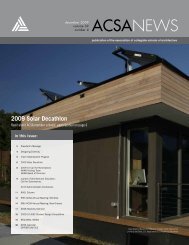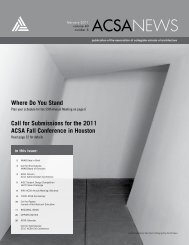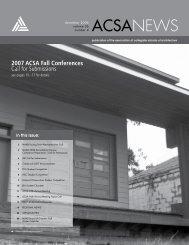digital aptitudes - Association of Collegiate Schools of Architecture
digital aptitudes - Association of Collegiate Schools of Architecture
digital aptitudes - Association of Collegiate Schools of Architecture
Create successful ePaper yourself
Turn your PDF publications into a flip-book with our unique Google optimized e-Paper software.
FRIDAY, MARCH 2, 2012 - 2:00PM - 3:30PM<br />
Emerging Materials, Renewable Energy, and Ecological<br />
Design (1)<br />
Franca Trubiano, University <strong>of</strong> Pennsylvania<br />
Drawing Energy Abu Dhabi: Critical Reflections<br />
Lisa M<strong>of</strong>fitt, University <strong>of</strong> Edinburgh<br />
Energy is central to sustainable discourse and yet it is <strong>of</strong>ten taught<br />
in a static, quantitative manner that denies it a more productive<br />
role in design thinking. As a design tool, energy’s behavioral abstraction<br />
and invisibility overwhelms, leading to conceptual inaccessibility.<br />
But it is only by engaging with energy as a spatial entity<br />
with organizational consequences and physiological impacts<br />
that it can take on agency in design thinking. In Autumn 2010, I<br />
taught Drawing Energy Abu Dhabi, a third year design studio that<br />
explored energy’s spatial and organizational consequences using<br />
the act <strong>of</strong> drawing energetic exchanges as a design generator.<br />
This paper is not an exploration <strong>of</strong> the aims and ambitions <strong>of</strong> the<br />
studio but a critical reflection <strong>of</strong> the gaps and misfires that occurred<br />
within the course. A reflection <strong>of</strong> these gaps reflects larger gaps in<br />
energetic thinking within the discipline. After generally introducing<br />
the Drawing Energy studio structure, the paper explores how contemporary<br />
educators and practitioners engage with the topic <strong>of</strong><br />
energy as a “spatial project” (Ghosn 2009). More specifically, the<br />
paper provides an expanded platform for discussing the behavior<br />
<strong>of</strong> energy, its scale and extents <strong>of</strong> operation, the taxonomic limitations<br />
that constrain thinking about it, and the representational<br />
opportunities that have the potential to deepen and enrich its role<br />
in design. The paper explores energy/matter exchanges at a foundational<br />
level in order to help build a shared understanding <strong>of</strong> more<br />
subtle ways in which energy informs the built environment.<br />
Biographical Statement: Lisa M<strong>of</strong>fitt is a Lecturer in Architectural<br />
Design at the University <strong>of</strong> Edinburgh. Lisa studied, practiced<br />
and taught in the US and Canada before moving to Edinburgh. In<br />
addition to teaching, she currently runs an independent practice,<br />
Studio M<strong>of</strong>fitt, which recently completed a design/build <strong>of</strong>f grid<br />
house in rural Canada. She is also completing a PhD in Design on<br />
Drawing Energy, which looks to establish a disciplinary vocabulary,<br />
tools and techniques for discussing and designing spaces that foreground<br />
thermodynamic principles.<br />
EcoArchitectural Machines<br />
Brook Muller, University <strong>of</strong> Oregon<br />
Ecological imperatives provide impetus to develop new materials,<br />
ones that are efficient, that adapt to environmental stimuli, minimize<br />
negative impacts on human and ecosystem health, etc. Yet<br />
it is not simply a matter <strong>of</strong> what assemblies we might devise and<br />
evaluate: a deeply ecological architecture calls for new forms <strong>of</strong><br />
‘accountability,’ new modes <strong>of</strong> describing materials, assemblies<br />
and their co-dependencies. Such an approach would emphasize<br />
projects as open experiments in the ‘arrangements’ <strong>of</strong> the living<br />
and nonliving. This essay considers how conceptual predispositions<br />
affect our ability to describe ecological materials and environments.<br />
It provides a speculative basis for aligning heterogeneous,<br />
event-laden ecologies and dynamic architectures <strong>of</strong> the city. It asks<br />
how urban interventions as hybrids <strong>of</strong> architectural fabrication and<br />
ecological regeneration might support a trajectory <strong>of</strong> enhanced<br />
human and biological diversity. Lastly it considers a proposal for<br />
an eco-architectural machine, a modest intervention that could be<br />
replicated throughout urban public spaces and that collapses architecture<br />
and ecology, establishes correspondences at vastly different<br />
scales, and aligns multi-sensory awareness, sociability and<br />
dramatically enhanced biological performance.<br />
Photosynthetic Energy and Ecological Recycling: The<br />
Architectural Potential <strong>of</strong> Algae Cultivation<br />
Gundula Proksch, University <strong>of</strong> Washington<br />
Designers are expanding the definition <strong>of</strong> Ecological Design by incorporating<br />
biological processes and systems directly in their design.<br />
Systems like green ro<strong>of</strong>s and living machines have proved<br />
themselves invaluable for reducing a design’s overall environmental<br />
footprint. Algae-based energy is almost 30 times less expensive<br />
per unit than energy generated by photovoltaic technology, and<br />
algae biodiesel can already be produced at market-competitive<br />
prices. With its efficient energy production and potential for improving<br />
the health <strong>of</strong> the surrounding air and water, algae cultivation<br />
is the next photosynthetically driven system primed for architectural<br />
integration.<br />
This paper examines the various methods <strong>of</strong> algae farming, its opportunities<br />
to support cyclical systems, its design implications, and<br />
its integration into urban space. The paper will support its findings<br />
with examples from built and speculative projects that centrally<br />
feature algae farming: The WPA 2.0 Competition winner, Carbon<br />
T.A.P.; Metropolitan Magazine’s 2011 Design Competition winner,<br />
Process-Zero: Retr<strong>of</strong>it Resolution; the Blenheim Municipal Wastewater<br />
Plant in New Zealand; a Algae Photo-Bioreactor in Klötze,<br />
Germany; and the Green Power House in Columbia Falls, MT.<br />
Cultivation methods range from low-tech open ponds to computer-automated<br />
bioreactors. Each method varies the balance <strong>of</strong><br />
yields, land, water, and energy usage, susceptibility to contamination,<br />
initial costs, and operating costs. Each system has very different<br />
design implications. Algae can effectively sequester carbon dioxide<br />
and treat wastewater while increasing its growth efficiency.<br />
These properties give it great potential for integration with other<br />
intrastructural systems like wastewater systems. These synergies<br />
can be developed into closed-loop systems within the built environment,<br />
resulting in lower CO2 emissions, nutrient reuse and efficient<br />
energy generation.<br />
These multi-layered benefits <strong>of</strong> algae cultivation initiate a rethinking<br />
<strong>of</strong> the relationships between sunlight, alternative energy and<br />
material recycling. This paper argues these new relationships have<br />
strong potential for future development <strong>of</strong> algae-integrated systems.<br />
Possibilities include integration into urban landscapes, existing<br />
building stock and power generation on the neighborhood<br />
scale. Challenges include economically down-scaling algal systems,<br />
onsite harvesting and the logistics <strong>of</strong> combining new infrastructures.<br />
To conclude, algae’s high ecological performance generates a<br />
multi-fold contribution towards improving the health <strong>of</strong> the environment.<br />
With its combination <strong>of</strong> carbon neutral/negative energy<br />
production and ecological recycling <strong>of</strong> environmental pollutants,<br />
the integration <strong>of</strong> algae cultivation in the built environment opens<br />
a new dimension to ecological design.<br />
Digital Apptitutes + Other Openings - Boston, MA - 21








